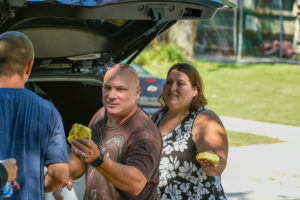By Josh Staloch
Correspondent
BROWN COUNTY – Right now in this community, there is a family with children ages 8, 10 and 12 who are living out of their vehicle.
Like other kids in school, the children are trying to stay ahead of early-semester assignments, but unlike their classmates, the worries of schoolwork pale in comparison to the concerns about staying warm and safe in the middle of the night while staring down the barrel of a fast-approaching winter.
The 2022 Point In Time Count, a meticulous count of every unsheltered individual in the area conducted in late July, found significant increases over last year’s number.

“We began the unsheltered homeless season – March and into April – with 30 people,” said Paul Van Handel, a member of Newcap’s Homeless Outreach Team (HOT). “You get into May, when it’s warm, and we’re starting to see this upward trend and almost a 150%-200% increase as we head into June and July.”
Van Handel said each new month of the unsheltered season in 2022 brought with it a doubling of the area’s homeless population.
Here’s what this year’s count shows:
In July of last year, there were 26 people classified as unsheltered Category 1, which means they are either literally homeless or living in a place not meant for human habitation.
In July of this year, the number more than quadrupled to 123.
By August the number had grown to 143 and as of Sept. 13 the number was up to 175 compared to 51 at the same time last year.
Among the homeless in the most recent count are two veterans and six families, including four children between the ages of 7 and 14.
Four families were trying to obtain hotel vouchers that may only last a week.
Functional zero
Van Handel partly attributes the increase to the simple fact that there is no available shelter housing in the area.
“Housing programs can’t place people if we don’t have the housing stock to place them into,” Van Handel said. “If we’re not having openings, not enough scattered-site housing, then you’re log jammed.”
He explained a term often used as a measuring tool in the fight against homelessness called “functional zero” to highlight how serious the problem is becoming for Brown County.
“Functional zero is kind of a formula they use to say ‘Okay, we don’t want more new people entering the system than you have leaving the homeless system in a one-year period of time,’” Van Handel said. “You’re trying to maintain an even level in the population and not have an increase. What we’re doing here, we’re growing our homeless population.”
He said in order for functional zero to be achieved, periods of homelessness for an individual should be rare, brief and non-recurring.
What’s happening in Brown County is the exact opposite.
“What we’re seeing now is that in this area, instances of homelessness are frequent, prolonged and recurring,” he said.
And contrary to popular belief that the issue is coming from outside of the area, Van Handel said most people lived in Northeast Wisconsin when they became homeless.
This is in spite of real efforts by the city to address the issue.

Van Handel said groups like Greater Green Bay Community Foundation and The Blueprint have been teaming up with other organizations in the area to develop a strategy to turn the problem around.
Out of that collaborative effort, he said a model is being created for peer-supported housing, wherein people who have significant mental health or alcohol or substance abuse issues can get help in a non-traditional environment.
“What we’re trying to do is put those folks in apartments where they can actually have their own life space,” Van Handel said. “Have some time to self-actualize and be with a peer, someone who essentially has had the same kinds of problems they’re having.”
How to help
While government officials struggle to get a grip on the homelessness problem, private citizens are trying hard to help.
Charitable individuals and groups stop by St. John’s Park regularly with food and other items to hand out to those seeking shelter in the pavilion.
But, oftentimes, those donations are doing more harm than good, Van Handel said.
“We ask that people use specific points where those who need the items can have safe access to them,” Van Handel saisd. “Shelters, pantries… St. Vincent DePaul, Paul’s Pantry, where they take in these hygiene items and all of this food so that they can be distributed to those who need them.”
For those looking for ways to help, advocates ask that you donate directly to one of the organizations listed above, or bring gift cards, gas cards (which would be greatly appreciated by the families who are living out of their vehicles) or grocery store gift cards directly to Newcap on Capitol Drive in Green Bay where they can be distributed by Van Handel himself.
